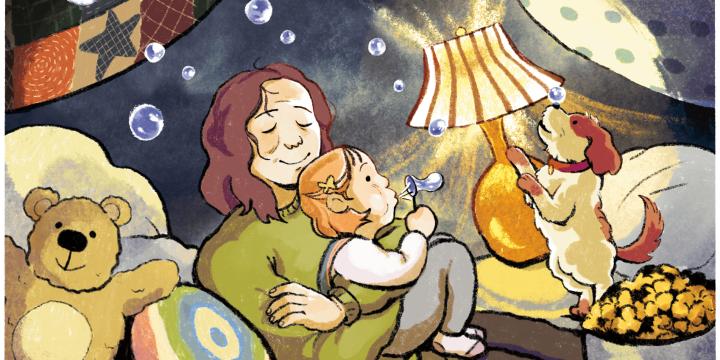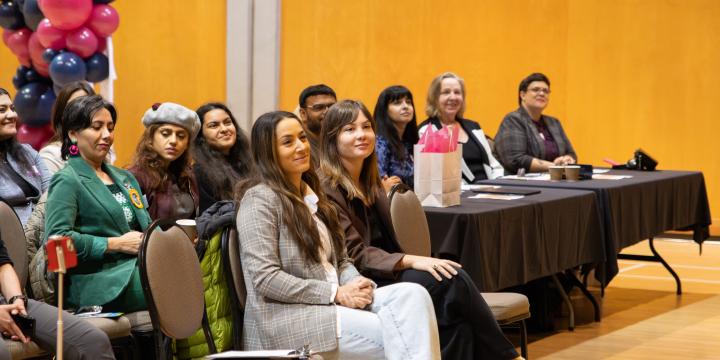
Why is it so Hard to Talk about Toxic Masculinity? Ten Men Share Their Thoughts
At the YWCA, we believe gender equality can only be achieved when women and men work together to create a more just and equitable society for everyone. Research has shown that toxic masculinity is a leading factor in the continuation of gender-based violence, so engaging boys and men continues to be a key focus of our work to end violence against women.
Toxic masculinity fuelled the senseless killings that took place on December 6, 1989, and continues to fuel so many other acts of gender-based violence to this day. To commemorate the National Day of Remembrance and Action on Violence Against Women, we’re taking a closer look at toxic masculinity – a set of attitudes that research has shown strongly contributes to violence against women. We spoke to ten influential men about the harms of toxic masculinity, why it’s important we discuss it and the steps we can take to unlearn the behaviours it supports.
Why are we talking about toxic masculinity and December 6?
From the l‘École Polytechnique massacre, to the 2014 Isla Vista killings, to the Toronto van attack just a few months ago, it’s clear that gender-based violence remains prevalent and that toxic masculinity is a glaring common denominator. Research has shown that when men feel that they don’t measure up, they’re more likely to act aggressively. Feelings of inadequacy can also increase their desire to commit sexual assault.
Let’s talk about what we mean by “toxic masculinity.”
Toxic masculinity (also known as hypermasculinity) refers to the narrow, limiting and repressive definition of being a “man”. It’s the glorification of stereotypically “male” traits and behaviours, like physical strength, aggression and sexual prowess. It’s also the idea that men and boys shouldn’t show their emotions, talk about their feelings or express vulnerability.
It’s important to remember that when we talk about toxic masculinity, we are not saying that masculinity is toxic. Toxic masculinity harms men and boys. It contributes to mental health issues, sexist attitudes and unhealthy relationships. Healthy masculinity is kind, honest, nurturing, vulnerable and sensitive to the needs of others. The behaviours and attitudes that stem from toxic masculinity are learned and socialized – meaning they’re a result of the cultural forces around us. With that in mind, it’s still up to us to make an active effort to recognize and unlearn toxic masculinity.
To understand how toxic masculinity is related to violence against women, we need to consider the culture we live in. Women and girls are sexualized – on television, in magazines and advertising and beyond. Women are seen as objects and their value is reinforced as such. At the same time, men are subjected to narrow ideals of hypermasculinization (or toxic masculinity), which embraces traits like aggression, power and callous sexual attitudes towards women. This creates a harmful power imbalance. It’s pretty clear, then, how closely the two are linked: the sexualization of women allows for mens’ dominant position in society, the hypermasculinization of men maintains that dominant position, and both ultimately feed into violence against women.
Back in October, during Week Without Violence, we published a blog about sexualization’s links to violence against women, and the need to shift this deeply ingrained culture if we want to create a society free from gender-based violence.
One of the steps we can take towards this is to examine and reflect on the harmful and limiting ways in which boys and men are socialized, and how toxic masculinity harms everyone. To encourage self-reflection and conversations among boys and men, we asked a few inspiring male allies to share their perspectives and advice. Because we can’t end gender-based violence without men’s participation and support.
Here’s what they had to say.
What is one myth of masculinity that men need to unlearn and why?
“One myth I see all the time is that masculinity or manhood is naturally violent. I often hear people say “well, hormonally…” or “men are hardwired to…” or something of that sort. Some people like to suggest that men’s violence against women is an inevitable result of men’s particular biology. I want to dismantle this over-simplified story. Violence is not the natural, biological, inevitable result of masculinity or manhood. It is, however, a socially-sanctioned expression of it (as is affirmed over and over by “boys will be boys” and “man up”). If we’re serious about ending violence against women, we have to destroy the idea that it’s inevitable.” - Alex Dauncey, Healthier Masculinities Program Coordinator, Sexual Assault Support Centre, AMS Student Society of UBC
 “There are so many, but the number one myth is that men shouldn’t demonstrate emotion, because this can lead to an inability to empathize. If we don't have healthy ways of addressing our emotional needs and can’t seek help, women tend to bear the brunt of it - from sexual violence, to dating violence, to violence in the home and workplace.” - Humberto Carolo, Executive Director of White Ribbon Campaign
“There are so many, but the number one myth is that men shouldn’t demonstrate emotion, because this can lead to an inability to empathize. If we don't have healthy ways of addressing our emotional needs and can’t seek help, women tend to bear the brunt of it - from sexual violence, to dating violence, to violence in the home and workplace.” - Humberto Carolo, Executive Director of White Ribbon Campaign
“It’s a myth that masculinity is about dominating ourselves and others. There are many ways of being a man, and in my conversations with men and boys I hear over and over that we really value men who show caring, listen to others, balance owning their own opinions with keeping an open mind to other perspectives, are honest and selfless. There is a myth that a “man’s man” is the alpha male, physically imposing, gets what he wants, is always in control of his emotions and his surroundings. Yet it seems that the “man’s man” we appreciate most is a caring human first, and his masculinity is about connecting with others rather than climbing to the top of food chain.” - Matt Schaaf, MANifest Change Project Manager
What is one practical way you show up as an ally to self-identified women?
“Empathizing is one of the greatest gifts that we as men can give to self-identified women as allies. The ability to listen to women’s experiences, validate them, share messages like ‘I’m sorry this happened to you, you didn’t deserve it, no one deserves it, I believe you, what can I do to help you, I’m here, I’ll support you.’ Encourage women to take whatever steps they need to take. Taking leadership with our peers by speaking up when something is inappropriate, recognizing our own privilege and engaging in self-reflection around our behaviours and attitudes is so important.” - Humberto Carolo, Executive Director of White Ribbon Campaign
 "I show up as an ally to self-identified women by using and by encouraging others to use gender-neutral language. I work with many exchange students whose first language isn’t English and often using gender-neutral language is not as common in other languages as it is in English. Gendered language creates a mindset that limits women to certain roles in society and it also discourages women from seeking other roles that are often dominated by men. This is why I encourage these English learners and others to expand their vocabulary with gender-neutral language so that we can create an inclusive society in which women aren’t excluded from any job or role." - Anthony Yuen, member of the YWCA Youth Advisory Council
"I show up as an ally to self-identified women by using and by encouraging others to use gender-neutral language. I work with many exchange students whose first language isn’t English and often using gender-neutral language is not as common in other languages as it is in English. Gendered language creates a mindset that limits women to certain roles in society and it also discourages women from seeking other roles that are often dominated by men. This is why I encourage these English learners and others to expand their vocabulary with gender-neutral language so that we can create an inclusive society in which women aren’t excluded from any job or role." - Anthony Yuen, member of the YWCA Youth Advisory Council
 “One practical way I show up as an ally is how I respond when I hear inappropriate jokes being made about gender. I pause, look them square in the eye and simply say “I don’t get it,” or “why is that funny?” That way, it’s not about being a jerk and calling them out. I also believe that you don’t need to “try” to be an ally, you need to practise being an ally - you don’t need to be an expert to make a difference.” - Mike Cameron, organizer of Ignore No More: Run for Respect
“One practical way I show up as an ally is how I respond when I hear inappropriate jokes being made about gender. I pause, look them square in the eye and simply say “I don’t get it,” or “why is that funny?” That way, it’s not about being a jerk and calling them out. I also believe that you don’t need to “try” to be an ally, you need to practise being an ally - you don’t need to be an expert to make a difference.” - Mike Cameron, organizer of Ignore No More: Run for Respect
“All people (but especially men) can show up for the women in their lives by being aware of women’s voices! Ask yourself how women have been socialized to use their voices and how men have. In my life, at least, it’s very clear that men are socially permitted to dominate conversations, whereas women are held to double standards of politeness and submissiveness. I can still remember when I realized how often women got interrupted or talked over. Here are some phrases I’ve started to use: “I don’t think she was done speaking”, “I’d like to hear the end of [name]’s sentence,” “to echo what [name] brought up...” The best practice is to notice and reflect on your own behavior and make a decision: is this a cultural habit you want to carry on?” - Alex Dauncey, Healthier Masculinities Program Coordinator, Sexual Assault Support Centre, AMS Student Society of UBC
“I show up as an ally by finding ways to initiate conversations about the need to end violence against women and children. In my case, I wear a small patch of moose hide on my shirt or jacket. This often results in strangers asking me about it, which then leads to a conversation about the Moose Hide Campaign, a grassroots movement of Indigenous and non-Indigenous men and boys that are standing up against violence towards women and children. ‘The most powerful tool in my personal arsenal is my words… I seek to use them in a way that is targeted towards the safety and well-being of women and children.’” - Paul Lacerte, Co-Founder and CEO Moose Hide Campaign Development Society
 “Aside from my work, I do my best to notice the ways in which we typically privilege the voices of men and seem to assume that men would make better leaders in our community. That means signal boosting and amplifying what women in my communities are saying, and in particular, women of colour, trans women and queer women.” - Pat Shannon, Staff Lawyer with YWCA Metro Vancouver Legal Education Program
“Aside from my work, I do my best to notice the ways in which we typically privilege the voices of men and seem to assume that men would make better leaders in our community. That means signal boosting and amplifying what women in my communities are saying, and in particular, women of colour, trans women and queer women.” - Pat Shannon, Staff Lawyer with YWCA Metro Vancouver Legal Education Program
What is one way you model healthy masculinity?
“I’m a dad – I have three sons, and one of the things I've always done with them is talk about our feelings and what it means for them to be respectful boys and young men. I always try to stay conscious of being a good role model, so that they can look back and say ‘my dad shared with me some really important principles that I’m living by today.’ In a very personal way, I model healthy masculinity by helping to raise a new generation of boys who are respectful, inclusive and treat women and people in an equitable way.” - Humberto Carolo, Executive Director of White Ribbon Campaign
 “I model a healthier masculinity that shows a broader, richer, and more complex repertoire of ways for being a man. This involves being honest, expressive, considerate, and caring toward other men while challenging the competitive, aggressive and combative manner in which some men typically attempt to prove heteronormative masculinity.” - Michael Kehler, Masculinities Studies in Education, University of Calgary
“I model a healthier masculinity that shows a broader, richer, and more complex repertoire of ways for being a man. This involves being honest, expressive, considerate, and caring toward other men while challenging the competitive, aggressive and combative manner in which some men typically attempt to prove heteronormative masculinity.” - Michael Kehler, Masculinities Studies in Education, University of Calgary
"I model masculinity by talking to other men about how I’m doing. I share my stressors, my insecurities and seek support from other men. This allows me to break down masculine stereotypes while giving space and permission for other men to come to me when they’re struggling. When I get emotional support from men I always thank them and let them know that the support they provide me will be returned. In my experience, when you share your emotions with other men your relationships become stronger and more intimate. In sharing your feelings with other men who experience the same feelings, they know they’re not in it alone." - Joe Campbell, WiseGuyz Facilitator
"I’m not sure that I do, which is something I’ve explored in my new book called ’This One Looks Like a Boy'. I do endeavour to find a level of comfort in my own skin, which is an ongoing project. As a longtime serial interruptor, I’m working hard to allow space for others to speak, to not blab on and on and talk over people — especially women — in our conversations. My partner and I have three teens, two boys and a girl, and they are my mirrors; every day, I’m forced to consider my actions and the impact they have on each of their identities and acceptance of who they are and how they will treat others." - Lorimer Shenher, Author
 "I hug my guy friends and tell them that I love them and that I appreciate them. Physical intimacy and acknowledgement of worth should not just come from romantic partners." - Jake Stika, Executive Director of Next Gen Men
"I hug my guy friends and tell them that I love them and that I appreciate them. Physical intimacy and acknowledgement of worth should not just come from romantic partners." - Jake Stika, Executive Director of Next Gen Men
“I’m trying to model healthy masculinity in the ways I communicate with others. By listening first, before all else. By being clear and assertive about my own boundaries and inviting others to be assertive with me. That means showing that I can take no for an answer and I can listen even when I disagree. There’s dignity for everyone in that practice. By challenging unhealthy behaviour in others and myself with curiosity, rather than shouting them down or shaming them. I’m trying to disarm shame so that we can increase our ability to be accountable for our mistakes and responsible for living up to our highest values.” - Matt Schaaf, MANifest Change Project Manager
 “I model healthy masculinity by practicing intimacy, which I refer to as “in to me see.” This is a practice of expressing my authentic self, even when it is uncomfortable or scary. One example is the practice of verbalizing feelings of insecurity and/or inadequacy, which can be very difficult to do. Healthy masculinity allows individuals to share their authentic self through healthy communication pathways and to create the space for safety, compassion, and humanity to grow and flourish.” - Paul Lacerte, Co-Founder and CEO Moose Hide Campaign Development Society
“I model healthy masculinity by practicing intimacy, which I refer to as “in to me see.” This is a practice of expressing my authentic self, even when it is uncomfortable or scary. One example is the practice of verbalizing feelings of insecurity and/or inadequacy, which can be very difficult to do. Healthy masculinity allows individuals to share their authentic self through healthy communication pathways and to create the space for safety, compassion, and humanity to grow and flourish.” - Paul Lacerte, Co-Founder and CEO Moose Hide Campaign Development Society
So now, we’re calling on men and boys to reflect and participate:
What problematic behaviours were you taught? How have they impacted you? How do you unlearn them?
Let’s #RedefineMasculinity together, and help eliminate gender-based violence.
What is December 6?
On December 6 1989, 14 female students at l’École Polytechnique de Montréal were murdered in an act of gender-based violence. In 1991, the Parliament of Canada declared December 6th the National Day of Remembrance and Action on Violence Against Women.
29 years on, unfortunately, not much has changed. Women around the world are still subject to high levels of violence – in fact, in the first six months of 2018 alone, 78 women across Canada were killed. Other statistics reveal that women are 11 times more likely than men to be sexually victimized and three times as likely to be stalked.
See a list of resources to find other local organizations that provide support for women leaving abuse.

